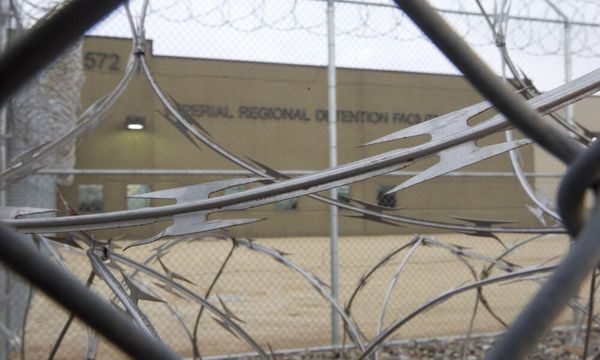
Max Hollein is sitting in his airy fifth-floor office in New York. Through one window is a view of Central Park, through another the rolling roofscape of the Metropolitan Museum of Art, which he has led for the past five and a half years. On his office walls are paintings by Lee Krasner and Helen Frankenthaler, Philip Guston and Jackson Pollock. There is also a Chola sculpture from India and the stone head of an Egyptian goddess.
In other circumstances, it might seem trite to open an interview with a tour of interior decor, but this is not any old office: it is a statement of taste and philosophy on behalf of one of America’s grandest cultural institutions. “Obviously, it’s not possible to capture the entire diversity of the collection,” says the museum’s 54-year-old director. “And of course, my own background is a little bit stronger in modern contemporary work. But I wanted to make sure I had a proper reflection of the art in the Met’s holdings.”
The facade of cool confidence that this control hub projects is at odds with the turbulence that many of the world’s great museums have been facing, as their dependence on arguably tainted money is challenged, their holdings scrutinised for any history of criminality, and questions raised about their very existence in the 21st century as self-appointed guardians of world culture.
As a 154-year-old museum, which has bought rather than inherited most of its possessions, the Met doesn’t carry the same burden of colonialism as its older European peers. But it shares many of their other problems. It was at the centre of Nan Goldin’s campaign against “narco philanthropy”. In 2018, the photographer and demonstrators threw pill bottles into the moat surrounding an ancient Egyptian temple in the Met, to protest against sponsorship by the billionaire Sackler family, owners of one of the world’s largest opioid-producing companies.
Meanwhile, an investigation last year identified hundreds of artefacts in its possession that were linked to indicted or convicted traffickers, leading to the immediate return of 15 sculptures to India and the removal from display of three others from Turkey.
Even in the context of the world’s mega museums, the scale of Hollein’s job is daunting. In a five-year renovation of some of the roofs beneath his window, about 30,000 sq ft of skylights has been replaced, culminating in November with the reopening of 45 galleries of European art. The aim was not only to spruce the place up, but to rethink its European heritage.
Among other things, this involved adding many more works by women. But beyond that, Hollein says, “the whole presentation really asks you, from the very beginning, what actually is Europe? What does it mean when we say European?” The new display extends the definition to include, for instance, Latin American Cuzco paintings. “They were highly influenced by European politics,” he says. “But they developed their own very complex style.”
The latest show to open applies a similar reframing to the Harlem renaissance, proclaiming it the first important African American artistic movement of 20th-century modernism. Alongside familiar names are artists whose work has never been widely seen, pieces lent by their families or the black colleges that have, says Hollein, sheltered them through decades of public indifference. “Showing the Harlem renaissance as a transnational movement and phenomenon is something that basically has not happened before.” The museum has also recently opened an exhibition of Mughal art, collected by the British artist Howard Hodgkin, which it bought two years ago.
Born and raised in Vienna, Hollein arrived at the Met via San Francisco’s Fine Arts Museums after making his name running institutions in Frankfurt. When he joined, the museum was in the run-up to its 150th anniversary. “Compared to some European institutions, 150 is not a great age,” he says. “But of course, in the American museum landscape, it’s an important anniversary to celebrate.”
Of the museum’s origins, back in 1870, Hollein says: “It just got founded, meaning that a couple of New Yorkers went to Paris, saw the Louvre and said, ‘We want this right now in New York.’ It was this crazy can-do mentality, when the reality was that they didn’t have one work of art. There wasn’t a building and they didn’t have a whole lot of money.”
Its relative youth freed the Met from the limitations that a longer history can bring. The museum is not beholden to the heritages of church or aristocracy, says Hollein, leaving it free to develop its collection as it wishes, without the statutory restrictions that prevent big British institutions from refreshing themselves. If it wants to sell an important Picasso sculpture because it has two – as it did last year, raising a handy $48.5m to reinvest elsewhere – it can do so.
Growing up in Vienna, Hollein did not frequent the Kunsthistorisches Museum. “It’s a museum I love, but I always understood it as the collection of the Habsburgs, not as a museum that represented myself, or even the values of Austria today.” As for Europe’s most visited museum, the Louvre in Paris, he says: “It is very clearly a national institution. It is a French institution. There’s a very different feeling and expectation to the Met. Yes, it sits in New York and is, of course, in the US – but it is not essentially a US institution. It’s much more a museum for, and of, the world.”
For those who don’t live within visiting distance of New York, the museum makes its presence known via the annual Met gala, an extravagant celebration of celebrity and costume that has been chaired since 1995 by Vogue editor in chief Anna Wintour, raising almost $22m (£17m) for it last year. That foundational jaunt to Paris began a tradition of funding through philanthropy that has become the Met’s greatest asset but also its greatest liability. Its historic acceptance of money from the Sackler family brought it an unwelcome starring role in Nan Goldin’s film All the Beauty and the Bloodshed, which turned opinion against money connected to the opioids crisis.
Hollein is undaunted. “That for me is not a crisis of how we can move forward or even how we are supported,” he says. “I see actually the total opposite. Yes, we have to take certain steps. But in the 1900s, there was a very specific group of people who supplied the culture. Now we have thousands and thousands of higher level donors not only across the whole political spectrum, but across the whole spectrum of society, who want to be involved and support the museum because of its important role in that society.”
The sponsors of the new modern and contemporary wing, a $500m development that will open in 2029, are a case in point. Designed by the Mexican architect Frida Escobedo, it will be called the Tang wing, after Oscar Liu-Chien Tang, a Shanghai-born American businessman and his wife, Agnes, who made a $125m donation in the midst of the Covid pandemic. “They wanted to make a gesture of confidence in the future. They also, I think, wanted to show a sense of pride in Asian Americans who have made a future for themselves in this country in such a major way.”
Four years ago, the pop sociologist Malcolm Gladwell lambasted the great museums of the world, including the Met, for what he called their “dragon psychology” – hoarding more objects than they could possibly display. It’s a concept that snowballed, with last year’s discovery that 1,500 items, many uncatalogued, had allegedly been stolen from the British Museum’s collection in London.
Hollein has little time for this idea, pointing to a recent gift by the daughter of Philip Guston of 220 works by her father. “Of course we couldn’t display 220 Gustons,” he says, “and we wouldn’t want to. She could have sold them for millions of dollars. But her feeling was that the Met is a great place to take care of this body of work, and to share it with other institutions.
“I think that it is really important to understand the museum as, first of all, a really good place for art objects. And what I mean by that is that museums play such an important role in preserving cultural heritage, enabling objects to thrive, to live, to be researched, conserved and also contextualised and shared in many different ways. So the idea that they are mainly hoarders is a misconception of why they were founded and what they are about.”
Part of the responsibility, he adds, is to ensure that every one of the Met’s 1.5m artefacts are properly documented. It also means scrupulous and constantly evolving oversight of their provenance. Although the museum doesn’t suffer from the colonial baggage of older collections, or the traumatic 20th-century history of Nazi seizures with which Hollein himself had to contend as director of museums in Germany, new information about provenance is continually coming to light, with a constant risk of serious reputational damage.
Back in 2009, it repatriated to Egypt 19 objects that were found to have been illegally taken from Tutankhamun’s tomb by the archaeologist involved in its discovery, Howard Carter. More recently, apart from the 15 Indian sculptures that were found to have passed through the hands of a dealer who is now in jail in India, it has returned two Benin bronzes to Nigeria, and 16 artefacts to Cambodia. Four new staff have recently been hired to manage the workload, says Hollein, and a new head of provenance research has just been announced. “We are very transparent. We not only announce all of our restitutions, but we publish updates on our website about what we’re doing in regard to provenance, research and restitution.”
After a rocky few years, the museum’s finances now seem stable, and nearly 6 million visitors passed through its doors in the last calendar year – nearly twice the number that visited the National Gallery in London but 2 million fewer than went to the Louvre. Hollein has no intention of hightailing it back to the subsidised cultures of Europe but, with the constant need to schmooze potential donors while managing nearly 2,000 staff and a budget of $320m a year, he has his work cut out – and after chatting for nearly an hour, I’m worried that he needs to get back to it.
He’s not quite finished, though. “One last thing,” he says, “is that among our peer institutions – the British Museum, the Louvre, the Prado [in Madrid], the Hermitage [in St Petersburg] – the Met is the one institution where the collection has no cutoff date. So we collect through time and through different cultures, from the beginning of artistic production to now.”
Not bad for a museum that, 154 years ago, was in possession of nothing more than a big dream.







